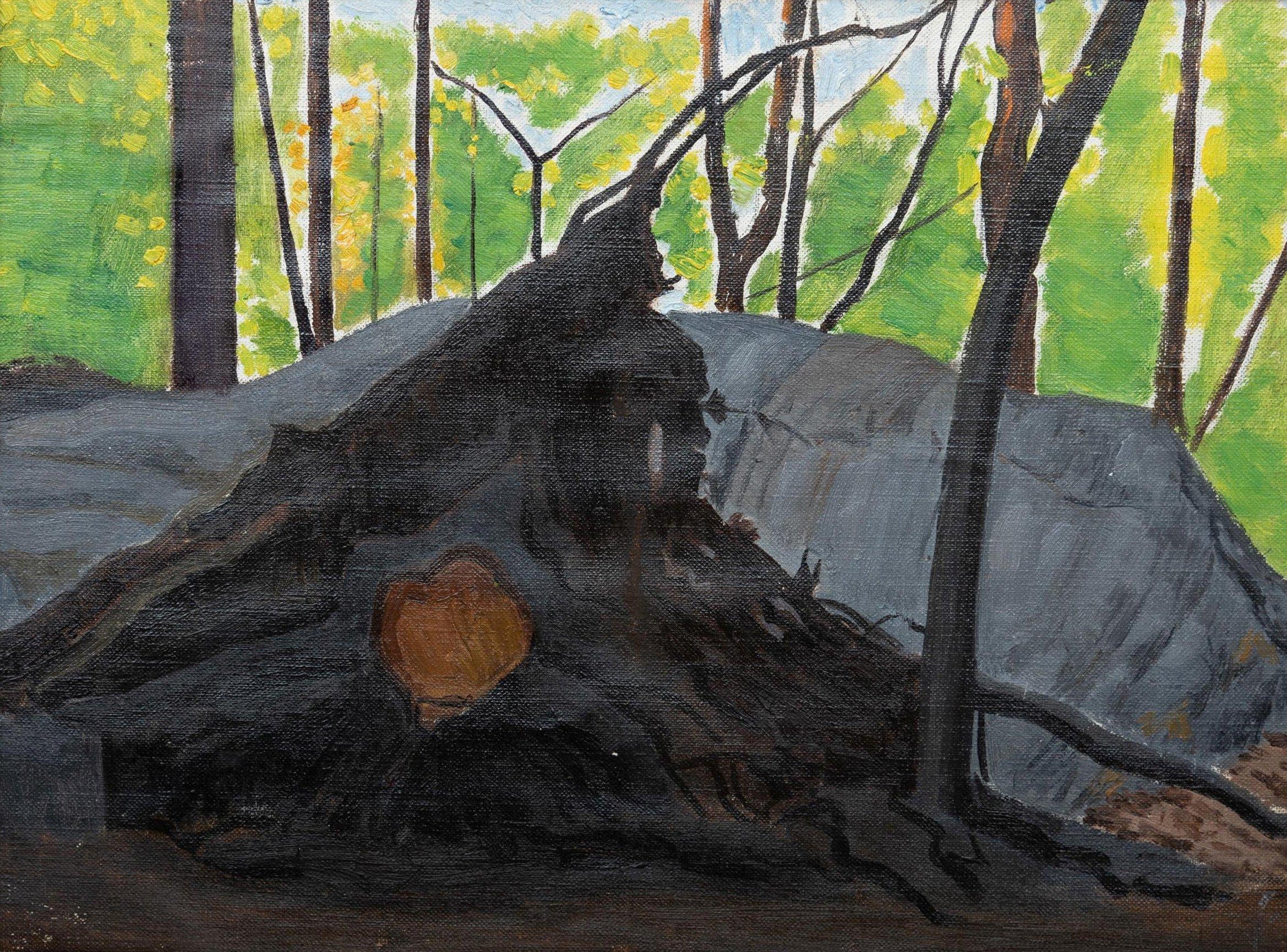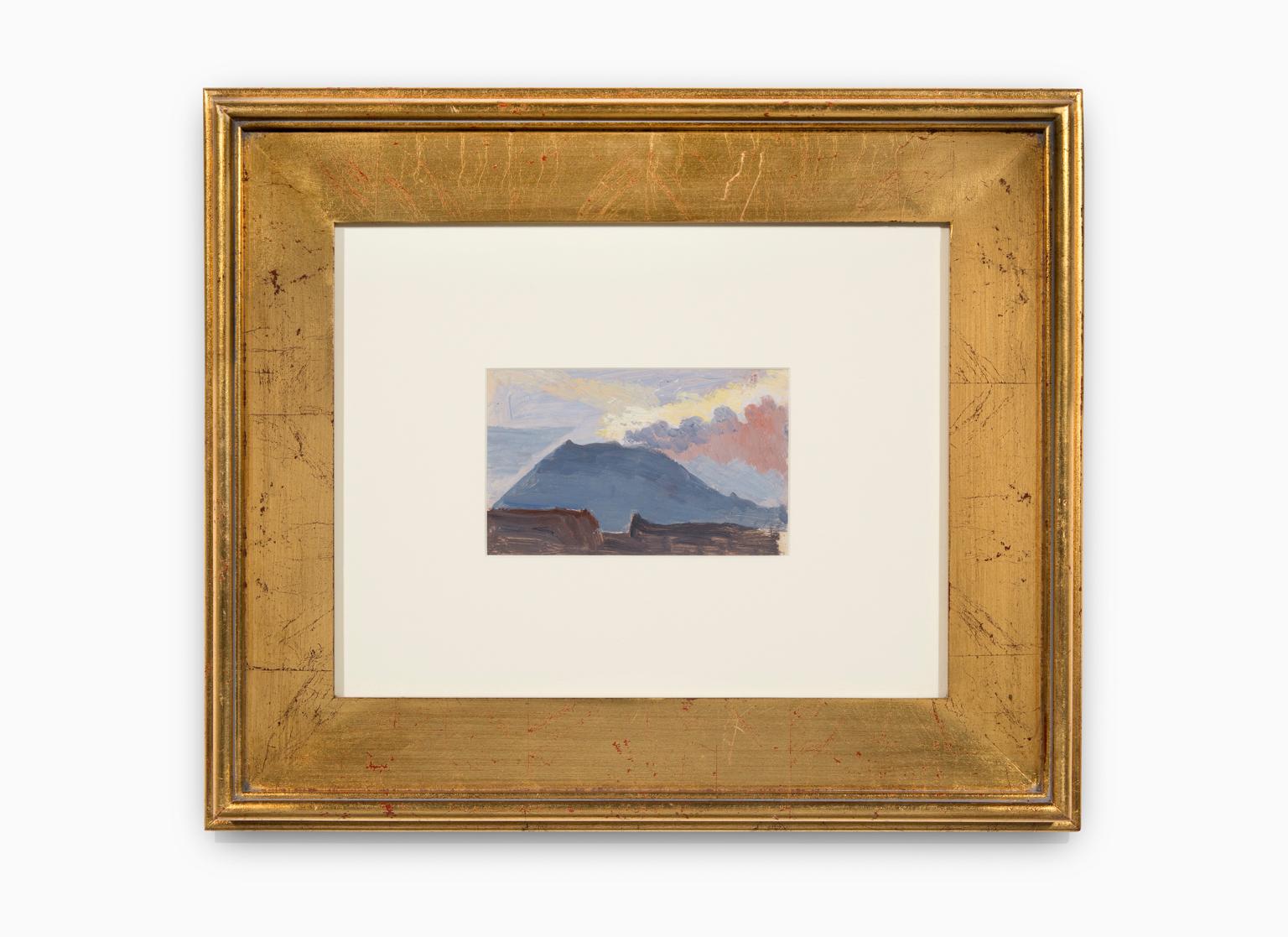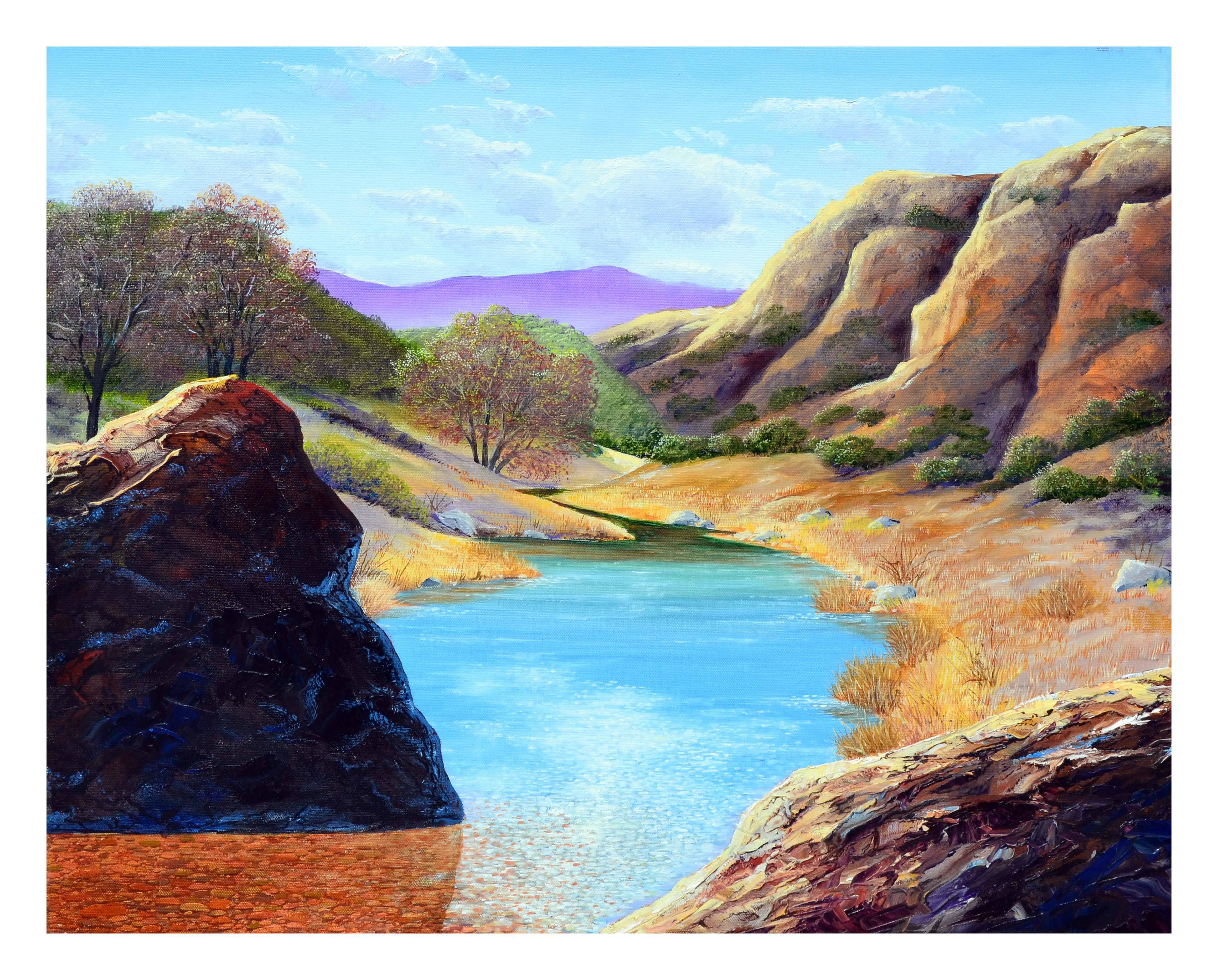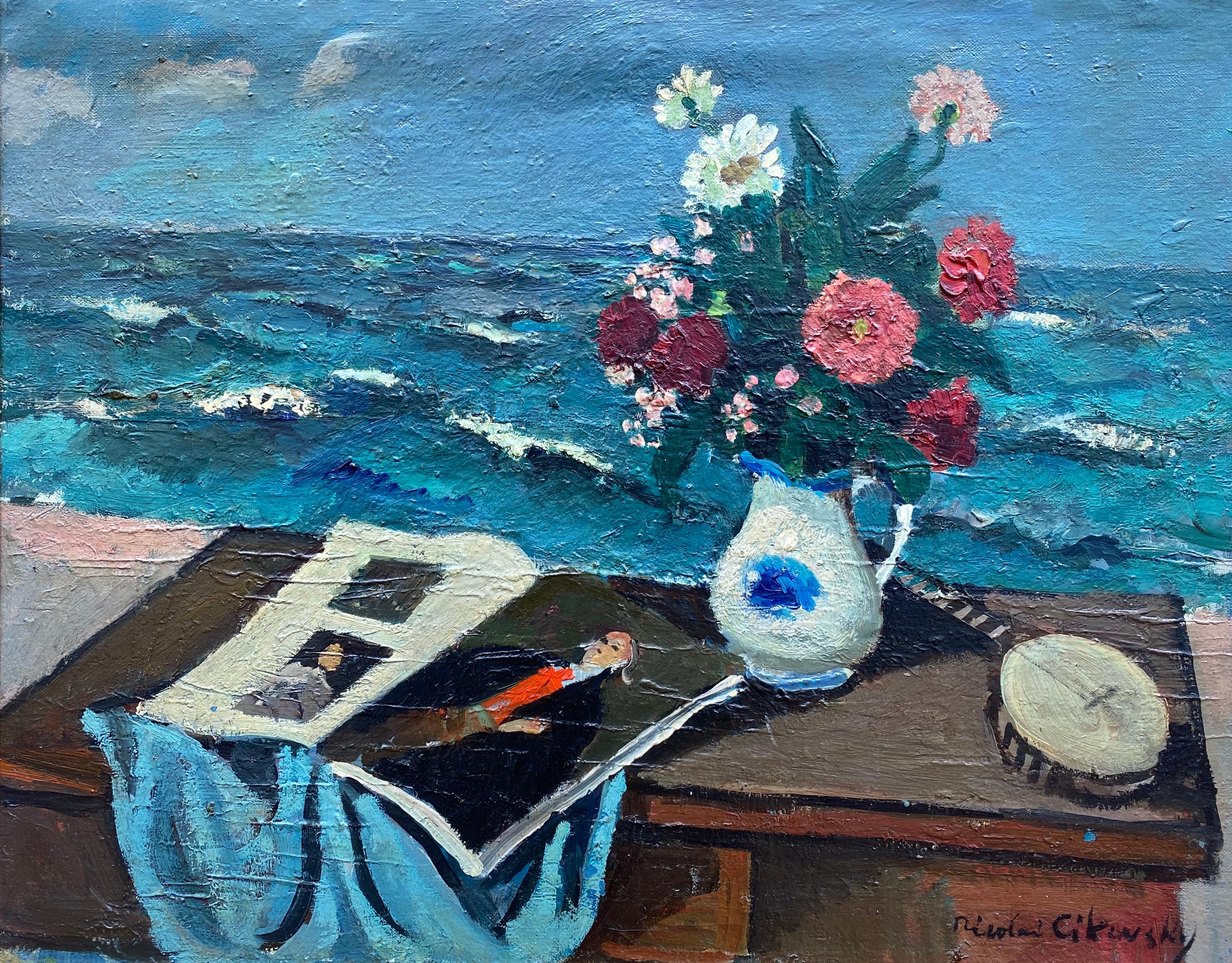Items Similar to Untitled (Country Landscape with Figures)
Want more images or videos?
Request additional images or videos from the seller
1 of 8
(William) Davenport GriffenUntitled (Country Landscape with Figures)1936
1936
About the Item
A Modernist landscape painting with figures by artist (William) Davenport Griffen. His paintings tend to be rare.
(William) Davenport Griffen was born in 1894 in Millbrook, NY. He graduated from Iowa State College in Ames, IA in 1918 with a B.S. in Civil Engineering; however, Griffen’s true love was painting. In 1919, he enrolled in the Chicago Academy of Fine Arts and subsequently studied at the Art Institute of Chicago from 1923-1928. In 1926, he was awarded the American Travel Scholarship and began painting in Provincetown, MA. In 1928, he was awarded the John Quincy Adams Scholarship and spent six months painting in Paris, France. Griffen also painted in the U.S. Virgin Islands for 11 months between 1930-1931. Griffen had one-man exhibitions of his Virgin Islands paintings at The Art Institute of Chicago and at Montross Galleries in New York, NY in 1931. Griffen exhibited at the Art Institute of Chicago 34 times between 1927 and 1943. He also exhibited at the Salon d’Automne in Paris, The Carnegie Institute in Pittsburgh, PA, The Pennsylvania Academy of Art, Philadelphia, PA, The Whitney Museum of American Art, New York, NY, The Corcoran Biennial, Washington, D.C., and the Century of Progress Exhibitions, Chicago, IL, 1933-1934. Griffen became an instructor of composition and life drawing at the Art Institute of Chicago from 1927-1930. He won numerous prizes for his work including the Augustus Peabody Prize from the Art Institute of Chicago in 1929 and The Logan Medal at the Art Institute of Chicago, 1930. Griffen completed two WPA post office murals, “The Good News and Bad”, Flora, IL, 1937 and “Service to the Farmer”, Carmi, IL, 1939. During WWII, Griffen once-again returned to his civil engineering background and served at the Naval air base in Glenview, IL and subsequently was employed by the U.S. Army Corps of Engineers in Joliet, IL where he met his wife, Loretta Simmons, in 1943. Griffen adopted her three children from her first marriage and they had a son together, Peter. After WWII, Griffen relocated to near San Francisco, CA where he continued to paint and exhibit, but also worked as a civil engineer. He died in Rohnert Park, CA in 1986. Griffen’s work is represented in the permanent collections of the Art Institute of Chicago, The Museum of Fine Arts, Boston and the Smithsonian American Art Museum, Washington, D.C. Griffen is one of the artists featured in the 1933 J.Z. Jacobson book, “Art of Today, Chicago”.
- Creator:(William) Davenport Griffen (1894 - 1986)
- Creation Year:1936
- Dimensions:Height: 15 in (38.1 cm)Width: 20 in (50.8 cm)
- More Editions & Sizes:Framed size: 22" x 24"Price: $3,500
- Medium:
- Movement & Style:
- Period:
- Condition:See Photos.
- Gallery Location:Chicago, IL
- Reference Number:1stDibs: LU2591212736072
About the Seller
5.0
Vetted Seller
These experienced sellers undergo a comprehensive evaluation by our team of in-house experts.
Established in 2000
1stDibs seller since 2023
12 sales on 1stDibs
Typical response time: <1 hour
- ShippingRetrieving quote...Ships From: Chicago, IL
- Return PolicyThis item cannot be returned.
More From This SellerView All
- Western View from Sun Deck on Ajax Mt, Aspen, Colo.By Harold HaydonLocated in Chicago, ILA small, colorful Modernist landscape painting by Harold Haydon, depicting "Western View from Sun Deck on Ajax Mt., Aspen, Colo.", dated 1955. This pain...Category
1950s American Modern Landscape Paintings
MaterialsOil
- Gospel Hall, Calais, VTBy Harold HaydonLocated in Chicago, ILA "Thumb Box" (diminutive) painting of the Gospel Hall in Calais, VT by Harold Haydon. Harold Emerson Haydon was born in Fort William, Ontario, Canada i...Category
1940s American Modern Landscape Paintings
MaterialsOil
- Untitled (Sunset)By Harold HaydonLocated in Chicago, ILA "Thumb Box" or diminutive painting by Harold Haydon depicting a mountain at sunset. Harold Emerson Haydon was born in Fort William, Ontario, Canada in...Category
1950s American Modern Landscape Paintings
MaterialsOil
- Vermont LandscapeBy Harold HaydonLocated in Chicago, ILA "Thumb Box" (Diminutive) painting of Vermont by Harold Haydon. Harold Emerson Haydon was born in Fort William, Ontario, Canada in 1909. Haydon came ...Category
1940s American Modern Landscape Paintings
MaterialsOil
- Vineyard LightBy Francis ChapinLocated in Chicago, ILA painting depicting a lighthouse in Martha's Vineyard by Francis Chapin, from around 1950. Francis Chapin, affectionately called the “Dean of Chicago Painters” by his colleagues, w...Category
1950s American Modern Landscape Paintings
MaterialsBoard, Oil
- Oak Bluffs, Mass. (Martha’s Vineyard)By Francis ChapinLocated in Chicago, ILA view of Oak Bluffs, MA on Martha's Vineyard by Francis Chapin, from around 1950. Francis Chapin, affectionately called the “Dean of Chicago Painters” by his colleagues, was one of...Category
1950s American Modern Landscape Paintings
MaterialsMasonite, Oil
You May Also Like
- "Tree, Trunk, and Roots, New York" Joseph Stella, American ModernismBy Joseph StellaLocated in New York, NYJoseph Stella (1877 - 1946) Tree, Trunk, and Roots, Bronx, New York, circa 1924 Oil on canvas 12 x 16 inches inscribed in another hand Joseph Stella/Estate and bears Joseph Stella Estate stamp (on the reverse) Provenance: The Estate of the Artist Rabin & Kreuger, New Jersey Parke Bernet Galleries, New York, March 14, 1968, Lot 147 ACA Galleries, New York Thence by descent Stella was born June 13, 1877 at Muro Lucano, Italy, a mountain village not far from Naples. He became painter laureate of Muro Lucano when he was in his teens with a representation of the local saint in the village church. Stella immigrated to America in 1896 and studied medicine and pharmacology, but upon the advice of artist friend Carlo de Fornaro, who recognized his undeveloped talent, he enrolled at the Art Students League in 1897. Stella objected to the rule forbidding the painting of flowers, an indication of his lifelong devotion to flower painting. He also studied under William Merritt Chase in the New York School of Art and at Shinnecock Hills, Long Island in 1901-1902, displaying the bravura brushwork and dark Impressionist influence of Chase. Stella liked to paint the raw street life of immigrant society, rendering this element more emotionally than the city realists, the Aschcan School headed by Robert Henri. Stella went through a progression of styles--from realism to abstraction--mixing media and painting simultaneously in different manners, reviving styles and subjects years later. The "Survey" sent Stella to illustrate the mining disaster of 1907 in Monongah, West Virginia, and in 1908 commissioned him to execute drawings of the Pittsburgh industrial scene. Steel and electricity became a major experience in shaping his responses to the modern world, and Stella succeeded in portraying the pathos of the steelworkers and the Pittsburgh landscape. Stella went abroad in 1909 at the age of thirty-two, lonely for his native land. He returned to Italy, traveling to Venice, Florence and Rome. He took up the glazing technique of the old Venetian masters to get warmth, transparency, and depth of color. One of Stella's paintings was shown in the International Exhibition in Rome in 1910 and was acquired by the city of Rome. The influence of the French Modernists awakened his dormant individuality. His friendship with Antonio Mancini, a Futurist, also played a role in his new style. At the urging of Walter Pach...Category
1920s American Modern Landscape Paintings
MaterialsCanvas, Oil
- "Study of Mt. Vesuvius" Oil on Canvas, Blue Tones, LandscapeBy Joseph StellaLocated in Detroit, MISALE ONE WEEK ONLY “Study of Mt. Vesuvius" is a small intimate painting of an active volcano that has at times wrecked great destruction. As seen from a distance, it is a calm blue ...Category
Late 20th Century American Modern Landscape Paintings
MaterialsCanvas, Oil
- Mount Hamilton Realist LandscapeBy Luke StamosLocated in Soquel, CAVivid, modernist Mt. Hamilton landscape attributed to Luke Stamos (American, 20th century). Oil on canvas. Unsigned. Unframed. Image size: 18"H x 24"W. This art work is in the distinctive realistic style of Luke Stamos. We certify that the work is by the hand of Luke Stamos. Artists statement: "I was born in Chicago, and began studying art at the Chicago Art Institute at age 5. When my family moved to San Francisco in 1944, I became aware of California’s splendid outdoor life, and began to pursue a life-long hobby of hunting and fishing. While attending high school in Daly City...Category
1980s American Modern Landscape Paintings
MaterialsCanvas, Oil
- "Garden Splendor"By Nicolai CikovskyLocated in Southampton, NYOil on canvas painting by the Russian/American artist, Nicolai Cikovsky. Signed lower left. In good unrestored condition. Housed in custom made wood and lemon gold gilt frame. Overal...Category
1940s American Modern Landscape Paintings
MaterialsCanvas, Oil
- “Bouquet by the Sea”By Nicolai CikovskyLocated in Southampton, NYOil on artist board original painting by the well known American artist, Nicolai Cikovsky. Thick vibrant colors with a vase of flowers, a banjo and a notebook with photographs with a rough sea as the background. Circa 1940. Condition is very good. Overall framed in a circa 1960 frame, 23 by 27.25 inches. Landscape and figure painter Nicolai S. Cikovsky, 1894-1984, was born in Russia, where he studied at the Vilna Art School, 1910-1914; the Penza Royal Art School, 1914-1918; and Moscow High Tech Art...Category
1940s American Modern Landscape Paintings
MaterialsCanvas, Oil
- Modernist Abstract Expressionist Watercolor Painting Bauhaus Weimar Pawel KontnyBy Pawel KontnyLocated in Surfside, FLAbstract watercolor composition bearing the influence of the earlier color-block compositions of Paul Klee. Pawel August Kontny, (Polish-German-American artist) He was born in Laurahuette, Poland, in 1923, the son of a wealthy pastry shop owner. In 1939 he began studying architecture in Breslau where he was introduced to the European masters and to the work of some of the German Expressionists, soon afterward banned as "degenerate artists" and removed from museums throughout Germany by the Nazi regime. His studies were interrupted by World War II. Drafted into the German army, traveling in many countries as a soldier, he sketched various landscapes but in 1945, he was captured and held as a prisoner of war in Italy. After the war, he studied at the Union of Nuremberg Architects to help design buildings to replace ones destroyed in the war. He recorded his impressions of the local population and the landscapes through his watercolors and drawings. Pawel Kontny thereafter moved to Nuremberg, Germany, becoming a member of the Union of Nuremberg Architects and helping to rebuild the city's historic center. He soon decided to concentrate on his professional art career. He married Irmgard Laurer, a dancer with the Nuremberg Opera. Pavel Kontny 's career as an artist was launched with his participation in an all German exhibition, held at the Dusseldorf Museum in 1952. He held one-man shows in Germany, Switzerland and the United States. During his trip to the United States in 1960, Kontny became instantly enamored with Colorado, and decided to relocate to Cherry Hills with his wife and two children. He quickly established himself in the local art community, being affiliated for a time with Denver Art Galleries and Saks Galleries. His subject matter became the Southwest. During this time he received the Prestigious Gold Medal of the Art Academy of Rome. His extensive travel provided material for the paintings he did using his hallmark marble dust technique. he also worked equally in pastel, watercolor, charcoal and pencil-and-ink. in a style which merged abstraction and realist styles, influenced by Abstract Expressionist painting and South Western American landscapes. In the early 1960s he was one of only a few European-born professional artists in the state, a select group that included Herbert Bayer (1900-1985), a member of the prewar Bauhaus in Weimar and Dessau, Germany, and Roland Detre (1903-2001), a Hungarian modernist painter. As a Denver, Colorado resident, Pavel Kontny exhibited at galleries and museums throughout the United States, Germany and Japan. There, he was inspired by frequent trips to Native American pueblos in the Southwest, as well as by the study of the Plains Indians of Montana and Wyoming. Over the years Kontny had a number of students and generously helped young artist by hosting exhibitions at his Cherry Hills home. For many years he generously donated his paintings to support charitable causes in Denver. Influences during his European years included German pastelist C.O. Muller, German Informel painter Karl Dahmen and Swiss artist, Hans Erni. In the early 1950s his painting style showed the influence of the Die Brücke (The Bridge), a group of German expressionist artists formed in Dresden in 1905 who had a major impact on the evolution of modern art in the twentieth century in Germany. By the middle of the decade his style incorporated more referential abstraction and total abstraction, resulting in part from his study of Hans Hartung, a German artist based in Paris who exhibited his gestural abstract work in Germany. The American moon landing in 1969 inspired Paul Kontny...Category
20th Century American Modern Landscape Paintings
MaterialsCanvas, Oil
Recently Viewed
View AllMore Ways To Browse
Modern French Country
Century Of Progress
New York Is Book Country
Washington State Landscape
Landscape In 1934
Wwii Painting
Good News
Wpa Landscape Painting
Artist Painting Landscape Wpa
Iowa Landscape
Landscape Painting By Adams
Naval Academy
Vintage Engineering Drawings
Farmers Wife
Landscape Oil Painting Naval
Oil Painting Artists A Z
Naval Academy Vintage
Davenport Vintage




